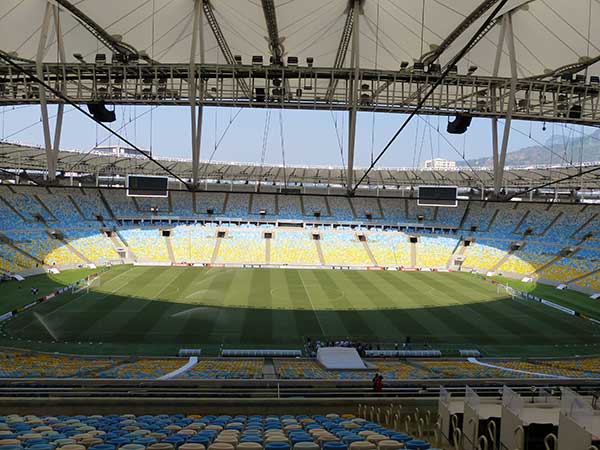Private tour to Maracana Football (soccer) Stadium in Rio de Janeiro

Brazil is considered the country of football, and not only by the passion of Brazilians for the sport. In addition to being the country with the largest number of World Cups and having the best players in history, both in men’s and women’s football (Pelé and Marta), Brazil has one of the world’s most famous stadiums: Maracanã.
Tip: reserve an English-speaking private tour guide in Rio de Janeiro
Founded in 1950, the Maracanã has attracted more than 200,000 spectators for one single game and has played host to football matches, music concerts (Frank Sinatra!) and other events. The most important stadium in Brazilian football carries with it part of Rio de Janeiro’s history and it is also one of the city’s main tourist attractions.
History of Maracana stadium
The story of Maracanã Stadium began in 1938, when the president of the International Football Federation (Fifa), Jules Rimet, visited Rio de Janeiro and accepted Brazil’s bid to host the 1950 World Cup. Brazil needs a big stadium as the headquarters for the Fourth World Football Championship, the first after the end of World War II.
On August 2, 1948, the first stone was laid and the stadium was built to be the largest in the world. The project took almost two years to complete and is estimated to cost 250 million cruzeiros (Brazilian currency at that time).
The stadium was built in an area of the city of Rio de Janeiro known as Tijuca, next to the Maracanã River. At the time, the Maracanã neighborhood did not exist, and it was not created until 1981.
Before anyone imagined that a stadium would be built on the pitch where the practice of another type of sport took place: touring. The land was acquired in 1885 by the Derby Club for horse racing, but the land was soon abandoned and became a depot for army cars.
Construction
The idea to build the new stadium on the former Derby Club came from the then Mayor of Rio de Janeiro, Mendes de Moraes. The decision was challenged by city councilor Carlos Lacerda (a future federal deputy and governor of the former state of Guanabara), who wanted the construction to take place in Jacarepaguá.
Back then, the Journals of Sports, commissioned by journalist Mário Filho, published several articles supporting the construction of the stadium in Tijuca. The newspaper also conducted a popular survey, which resulted in preference for the same region.
Work began in 1948. The stadium’s architecture consisted of an oval structure with an impressive capacity for 200,000 people. The stadium was 32 meters high and its axes were 317 meters and 279 meters.
On June 16, 1950, the stadium was inaugurated with the name Mendes de Moraes stadium or Derby municipal stadium. The first match took place the next day between the Rio de Janeiro team and the São Paulo team, being the first goal of the stadium scored by midfielder Didi, for the Cariocas, but the São Paulo team turned the match, which ended on 3-1 for the visitors.
The stadium was inaugurated incomplete, with parts of the structure unfinished. At the time of the World Cup, there were still scaffolding and piles of bricks, for example, that offered little security and almost nothing in the way of comfort, but that didn’t stop the event from happening.
World Cup 1950
Brazil was the favorite to raise the football World Cup. One month after the inauguration of the world’s largest stadium on July 16, Maracanã lived one of the most memorable days in its history. The final between Brazil and Uruguay silences the 199,854 supporters present. The biggest audience at the stadium has so far been mute as Brazil was beaten by visitors 2-1. The episode is known as Maracanazo. In Spanish, the suffix “azo” is used to mean something grandiose.
Renaming
Although Brazil’s national team bitterly lost to Uruguay in the 1950 World Cup, major matches are being staged in Maracanã and big names in national football are shining on the stadium’s lawns, such as Garrincha, Pelé, Zico, and Romário, but an important name for the stadium’s history has never been forgotten: Mário Filho.
The sports journalist was considered one of the most influential in the country and fought hard to support the idea of building the Maracanã at the site of the former Derby. He loved the stadium by bringing all social classes together to enjoy football. That is why, after his death and in his honor, the Maracanã received the official name of Estádio Jornalista Mário Filho.
Mario died in 1966, at age 58, of a heart attack. His brother, the well-known columnist Nelson Rodrigues, famously praised him for his influence on the popularization of soccer in the country under the epithet “The Creator of Crowds.”
Tip: reserve a private tour to visit Selaron Steps
Why take a private tour of the football stadium?
In general, some of the advantages of taking any private tour are:
- Save time
- Feel safer
- Avoid long lines
- Learn about the site
- Get insider’s information and tips
